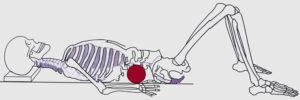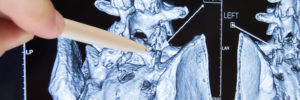
Preventing Low Back Pain: What Radiology Can Tell Us About Exercise Decisions
Ever since I injured my low back and did my rehab several years ago – I developed an interest in spine biomechanics.
It’s ironic since I did a masters degree in exercise physiology. But my lower back problems and strength & conditioning roles with the Windsor Spitfires and Toronto Raptors changed my interest. And spine biomechanics is the one field that I have found to be most applicable.
What fascinates me about the spine is how a change in spinal position or degenerative change in the spine alters force vectors.
For instance. Take someone with a loss of disc height or degenerative facet joint in the lumbar spine.
A loss of disc height will shift more force to the facet joints (1) – resulting in an increased risk of osteoarthritis (4).
Degenerative facet joints don’t move well (5,6). And a healthy facet joint above or below a degenerative facet joint will compensate for abnormal movement from a degenerative one (2) – perhaps increasing the risk of osteoarthritis.
Taking it one example further – look at spinal fusion surgeries.
People who undergo spinal fusion surgery are at an increased risk of facet joint osteoarthritis (7). Removing a spinal disc and fusing bone together will disrupt normal spine mechanics. The adjacent facet joints will absorb more load from the removal of a spinal disc (7).
Think about squatting or deadlifting with these problems. How will forces move in a spine with degenerative changes? I can tell you – it won’t be normal and compensation will occur somewhere.
From a strength & conditioning and personal training perspective – your training people every day with degenerative changes in their spine. Whether you know it or not.
Consider these statistics from a few research studies:
- 63 of 98 people without low back pain were found to have a disc bulge, disc herniation or disc extrusion (3).
- 88 of 98 tennis players without low back pain were found to have degenerative facet joints and 30 of 98 having a disc herniation (8).
- 308 of 1025 athletes with low back pain were found to have a case of spondylolysis (9). Sports including baseball, soccer and hockey the most prevalent in males; Gymnastics, marching band and softball most prevalent in females (9).
While the population your training is going to influence your exercise decisions – you can perhaps assume that about 2/3rd’s of the general population have a disc bulge, disc herniation or disc extrusion. And for an athletic population, there is a good chance your training an athlete with spondylolysis or degenerative facet joints.
In many cases, people may be asymptomatic. But a failure to understand the degenerative changes that develop in people – may worsen training decisions and result in asymptomatic people becoming symptomatic. Not a result we want.
With advancements in radiology – strength coaches or personal trainers have an idea of what degenerative changes develop in people, and this could improve training decisions.
Salute,
Remi
References
1. Dunlop, R. B., Adams, M. A., & Hutton, W. C. (1984). Disc space narrowing and the lumbar facet joints. The Journal of Bone and Joint Surgery. British Volume, 66(5), 706–710.
2. Jaumard, N. V., Welch, W. C., & Winkelstein, B. A. (2011). Spinal Facet Joint Biomechanics and Mechanotransduction in Normal, Injury and Degenerative Conditions. Journal of Biomechanical Engineering, 133(7), 01-31.
3. Jensen, M. C., Brant-Zawadzki, M., Obuchowski, N., Modic, M. T., Malkasian, D., & Ross, J. S. (1994). Magnetic resonance imaging of the lumbar spine in people without back pain. The New England Journal of Medicine, 331(2), 69-73.
4. Fujiwara, A., Tamai, K., Yamato, M., An, H. S., Yoshida, H., Saotome, K., & Kurihashi, A. (1999). The relationship between facet joint osteoarthritis and disc degeneration of the lumbar spine: an MRI study. European Spine Journal. 8(5), 396–401.
5. Fujiwara, A., Lim, T. H., An, H. S., Tanaka, N., Jeon, C. H., Andersson, G. B., & Haughton, V. M. (2000). The effect of disc degeneration and facet joint osteoarthritis on the segmental flexibility of the lumbar spine. Spine, 25(23), 3036-3044.
6. Fujiwara, A., Tamai, K., An, H. S., Kurihashi, T., Lim, T. H., Yoshida, H., & Saotome, K. (2000). The relationship between disc degeneration, facet joint osteoarthritis, and stability of the degenerative lumbar spine. Journal of Spinal Disorders, 13(5), 444-450.
7. Park, P., Garton, H. J., Gala, V. C., Hoff, J. T., & McGillicuddy, J. E. (2004). Adjacent segment disease after lumbar or lumbosacral fusion: Review of the literature. Spine, 29(17), 1938–1944.
8. Rajeswaran, G., Turner, M., Gissane, C., & Healy, J. C. (2014). MRI findings in the lumbar spines of asymptomatic elite junior tennis players. Skeletal Radiology, 43(7), 925-32.
9. Selhorst, M., Fischer, A., & MacDonald, J. (2017). Prevalence of spondylolysis in symptomatic adolescent athletes: An assessment of sport risk in nonelite athletes. Clinical Journal of Sport Medicine: Official Journal of the Canadian Academy of Sport Medicine.
Thumbnail Image Licensed from “eggeeggjjew/depositphotos.com”











